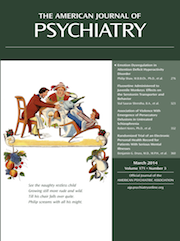Management of Treatment-Resistant Major Psychiatric Disorders
While the notion of treatment-resistant psychiatric disorders may bring to mind narrowly defined subsets of severely ill individuals not normally encountered by the average mental health care provider, the definition employed in this volume is considerably more encompassing, to include patients who experience persistent psychiatric symptoms with impaired functioning despite one or more adequate treatment trials. The book chapters represent thoughtfully distilled tutorials on how to manage everyday clinical challenges across the major psychiatric disorders, including a range of mood and anxiety disorders, schizophrenia, substance abuse, and insomnia, as well as anorexia/bulimia nervosa, personality disorders, and one chapter on childhood mood and anxiety disorders.
It is interesting to compare how treatment resistance is approached across the various disorders. For major depression, formal treatment-resistant staging methods have been articulated both in the United States and internationally. Large-scale clinical trials, such as the Sequenced Treatment Alternatives to Relieve Depression Study, have unequivocally established the high prevalence of treatment resistance for people with major depression, and evidence-based treatment algorithms for treatment-resistant depression are beginning to emerge. Despite the modest added efficacy of each subsequent antidepressant, it is also encouraging to note that the 10-year remission rate approaches 90%. Schizophrenia is another diagnosis that has a formalized definition of treatment resistance, which emerged from the need to determine the appropriateness of patients who could be considered for clozapine therapy. While clozapine was approved over 20 years ago in the United States, the schizophrenia chapter makes it clear that there remains a dearth of proven options beyond clozapine for treatment-resistant schizophrenia. And although not emphasized in the text, it continues to be the case that only a fraction of clozapine-eligible patients ever receive a clozapine trial for reasons that appear to have less to do with the risk of actual side effects but rather with the burdens and hurdles associated with ongoing hematological monitoring.
Most other disorders do not have formally defined treatment-resistant subtypes, but the prevalence of persistent and debilitating symptoms is a ubiquitous problem. For example, in patients with anorexia nervosa, the authors emphasize that almost every patient has very difficult-to-treat symptoms, that full remission is rarely achieved, and that most patients have at least some “treatment resistance.” Similarly, in the chapter on personality disorders, Dr. Gabbard emphasizes that personality disorders have always been difficult to treat and that the term “treatment resistant” could also be designated “more difficult than usual.” This chapter offers a surprisingly hopeful assessment of the long-term outcome for patients with treatment-resistant personality disorders. For example, a recent 10-year prospective study of patients with borderline personality disorder, funded by the National Institute of Mental Health, found that over 90% of patients achieved remission of symptoms that lasted at least 2 years, although somewhat over 30% of remitted patients subsequently experienced a relapse. Furthermore, at least seven distinct psychotherapeutic approaches for borderline personality disorder have demonstrated efficacy in randomized controlled trials. This therapeutic armamentarium should help practitioners individualize treatment approaches for their patients.
Given that most psychiatric disorders are chronic and relapsing, this book represents an unusually practical text that combines standard treatment protocols with less conventional but eminently usable treatment suggestions for recalcitrant symptoms. All practicing psychiatrists and more advanced trainees can benefit from having this book on their shelf.



